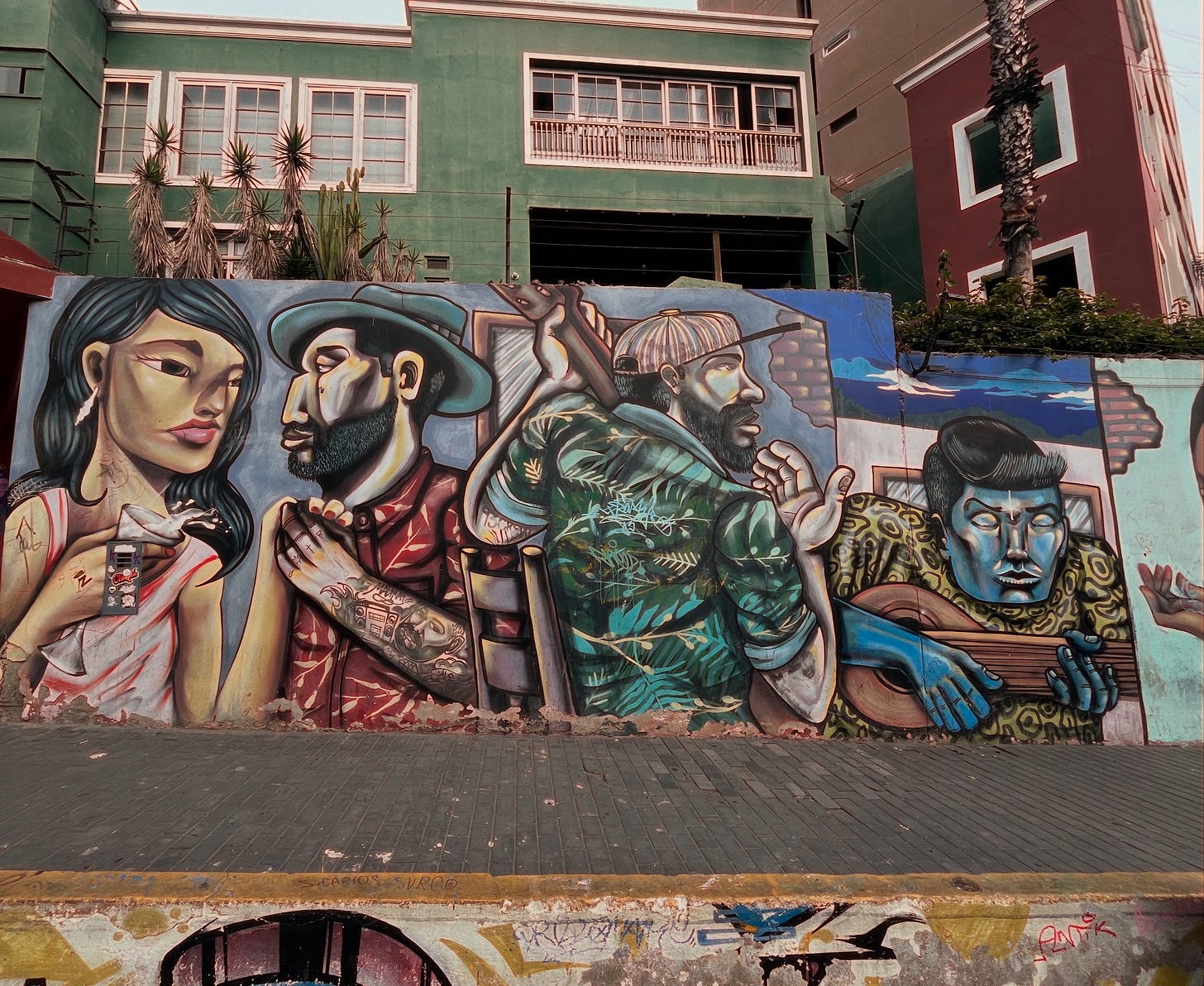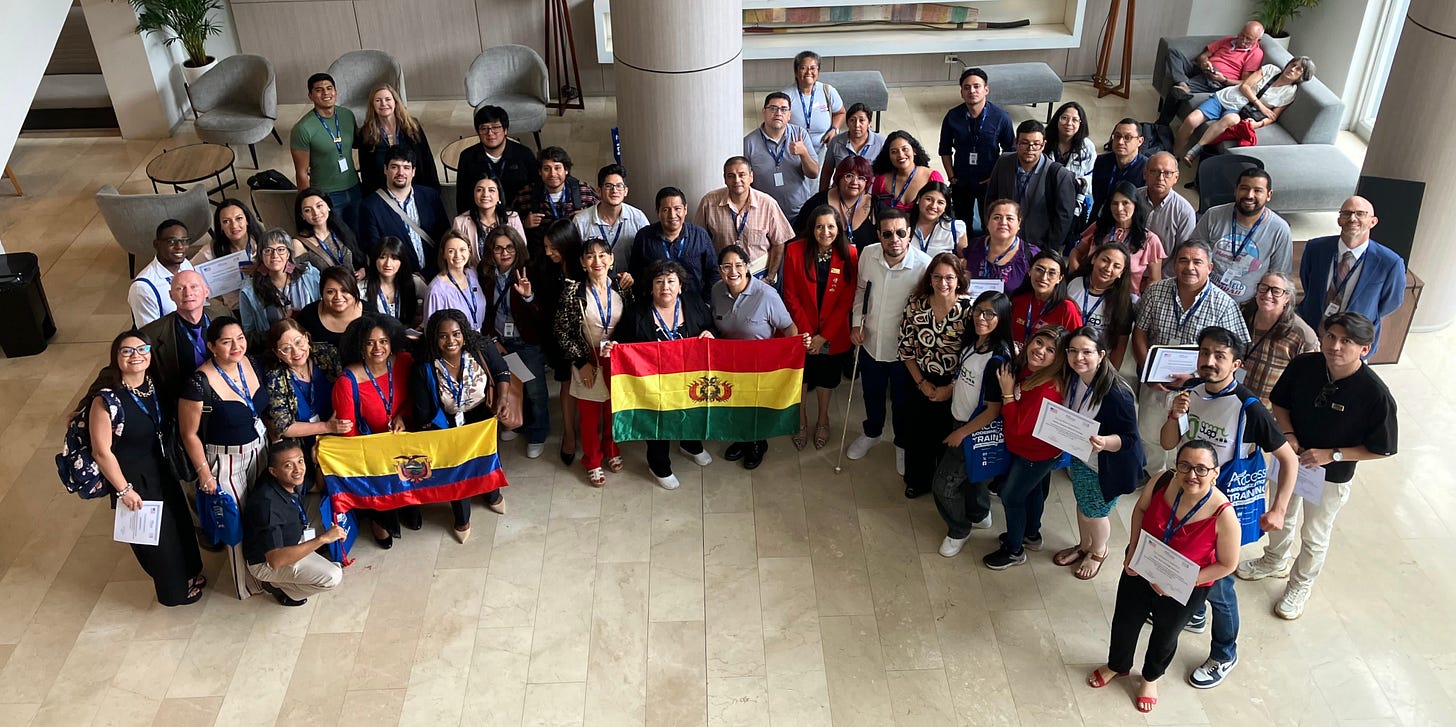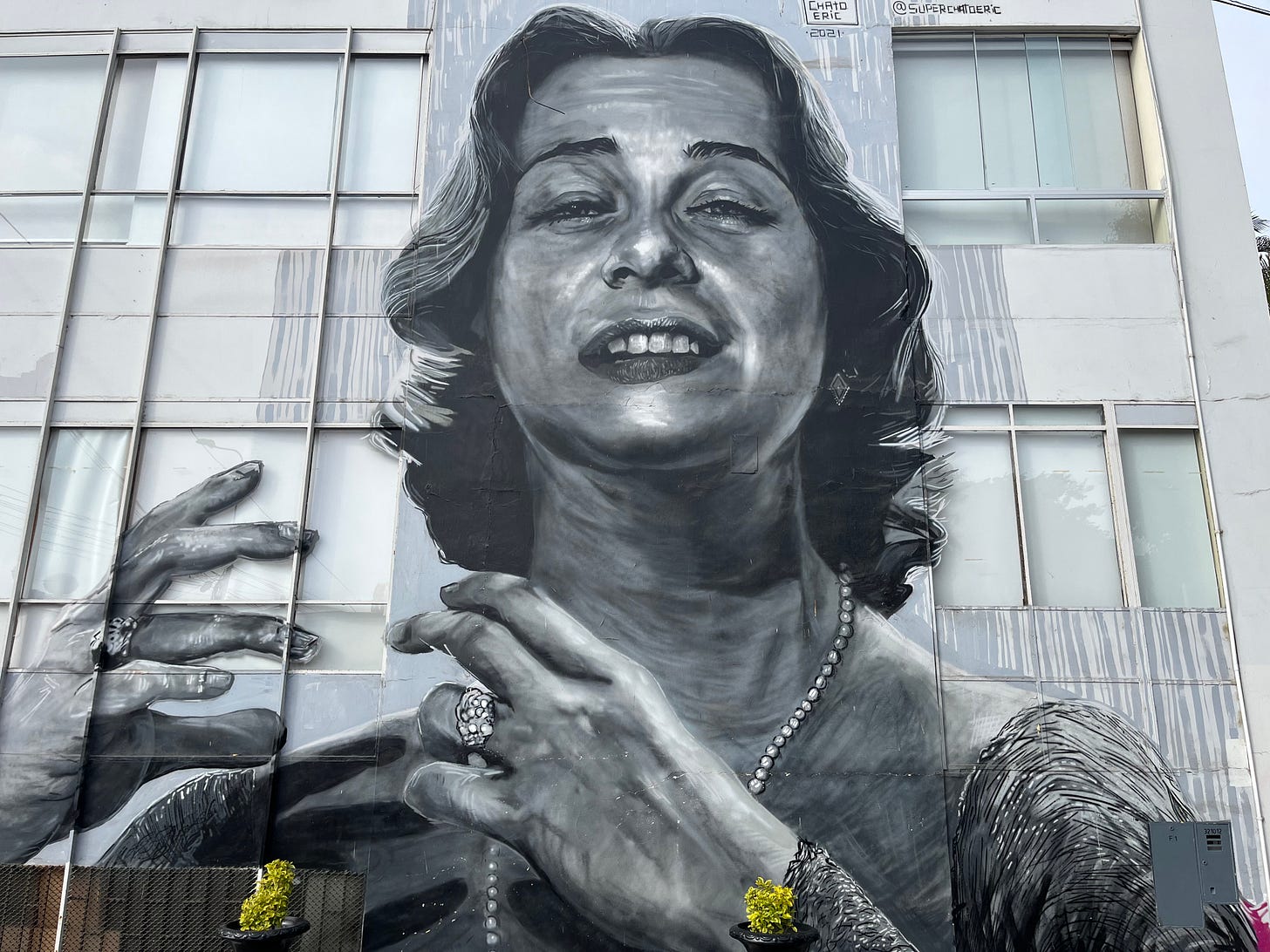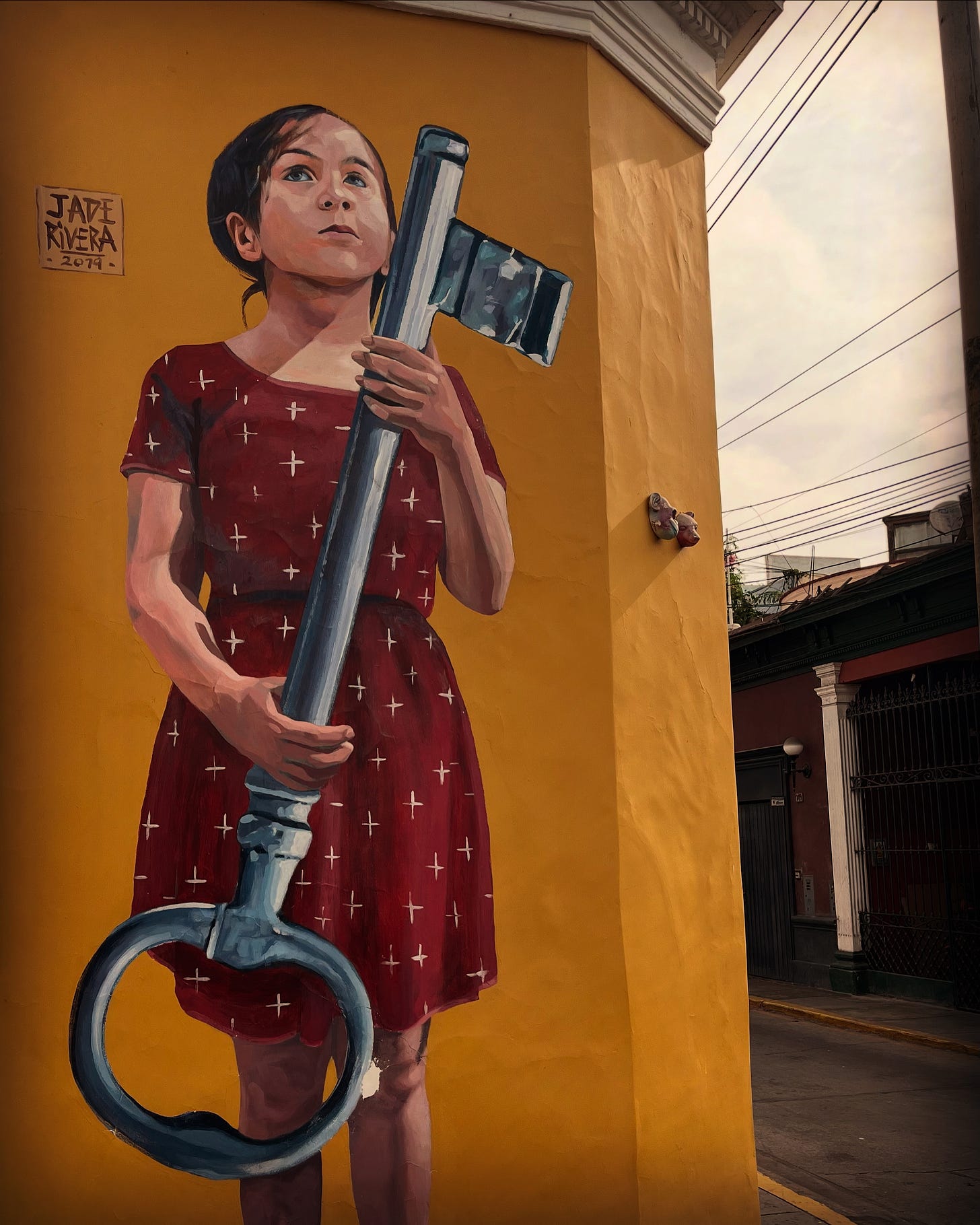Unity through Difference
Including compared perspectives, contested histories, Peruvian music and cuisine, and South American muralists
Hola mi gente,
I’m back from my week in Lima, Perú. We had an amazing training with educators from Bolivia, Ecuador, and Perú, but it wasn’t without some hiccups along the way. With the Trump administration’s recent dismantling of USAID and the ongoing assault on diversity, equity, and inclusion (DEI), it was a pretty crazy week to be working abroad on a U.S. federally funded project. Up until only a few weeks ago, one of the global citizenship themes of the English Access Scholarship Program was “DEI,” which has since been changed to “Community and Belonging.” We were forced to change a lot of the language in our workshop materials so that it reflected current policy. Removing words like “inclusive” seemed especially ironic as one of our goals was to adapt materials for two visually-impaired English teachers who were part of the training.
At midweek, we were fortunate to go on a tour of Lima's Historic Centre with workshop participants. We walked through the expansive plaza at the heart of Lima while looking at the beautiful colonial-era buildings surrounding it and the Andean foothills beyond. When we entered Lima’s stunning cathedral, I was handed a little card with a short prayer of unity on it. As I read it something immediately felt wrong. Classical music was gently playing in the background of this nearly 500-year-old cathedral and I sat down on a pew to take it all in. After a while I realized that I didn’t like how the prayer advocated for unity through “sameness” or “oneness.” If we somehow were to achieve unity through “sameness,” life would be reduced to something far less that it actually is. It reminded me of Nigerian author Chimamanda Ngozi Adichie’s TED Talk on the dangers of a single story, where she encourages us to see the multiple layers of people and cultures, and to fight powers that would seek to silence them. Some would argue that the silencing is already taking place. It’s why I’m appreciative of people like Kendrick Lamar, who publicly give voice to a counter narrative, both directly and symbolically. If we’re ever going to get to a place of unity, we have to do so through accepting and embracing “difference.”
So with that, here are 5 things magnifying “difference” that I thought about while working in Perú:
We understand life better through different perspectives. One of our sessions in Perú was geared toward helping teachers develop service learning opportunities for their students. I shared a story about one such project I did years ago with some middle school students who were struggling both academically and behaviorally in their classes. After reading Paul Fleischman’s wonderful books on perspective: Seedfolks and Joyful Noise: Poems for Two Voices, I organized an opportunity for them to volunteer at a local assisted living facility. They designed interview questions to ask their assigned elderly resident, with the goal of gathering data that they could later use to compare their lives one another. After the event, they wrote about their experience in a comparison poem that represented two unique perspectives on life. It was a wonderful exercise of serving community and comparing perspective across generation and culture. I’ve done a similar activity with East Meets West cards, which compare eastern and western ways of viewing the world. Another powerful example of poetry that compares perspective is Lucinda Williams’s “Soldier Song,” covered in this video by Sean Rowe, who through his ethereal and deep baritone voice adds his own unique perspective to the song’s meaning.
History is actually composed of multiple histories. We tend to hear the version of those who had the power to tell it. But if we dig deeper, we’re bound to find untold histories that reveal a more complete picture. Much of the Andean region of South America, including Ecuador, Bolivia, and Perú, have a common independence story. Before any country borders had been drawn, all of these lands were in a fight to gain their independence from Spain. After touring Lima’s Historic Centre with teachers from each of these three countries, it became evident, maybe unsurprisingly, that their perspective on the history of independence seemed to be substantially influenced by their country of origin. I enjoyed observing these conversations between participants. And if we go further back, we find that history has always been contested. The Inca occupied the Andean region long before Spanish colonizers. One of them was Felipe Guaman Poma de Ayala (a.ka. Huamán Poma), an Inca nobleman who called out the abuses of Spain’s colonial regime and insisted in the legitimacy of Incan history pre-conquest. The indigenous histories of the Andean region are extensive, as revealed in Perú: A Journey in Time, and I hope to return someday to visit the negative spaces of the Nazca lines and experience Machu Picchu.
A sense of place is created by the different genres of music and languages found there. I listened to a wide range of really good Peruvian music ahead of my trip to Perú and while I was there. Los Destellos are a cumbia rock band whose self-titled album (1968) reminds me a lot of Dick Dale’s surf rock. Chabuca Granda is a singer and composer who incorporated a lot of Afro-Peruvian rhythms into her criollo waltzes of the ‘60s and ‘70s. Her album Tarimba Negra (1978) is ranked at #20 on the list of top 600 Latin American albums, and there’s a 2017 tribute album to her music called A Chabuca that’s worth checking out. La Lá is a singer-songwriter who blends bossa nova with folk pop, and advocates for female empowerment on her second album Zamba Puta (2017). And finally, Renata Flores went viral in 2015 when she was only 14 years old for her Quechua cover of Michael Jackson’s “The Way You Make Me Feel.” She’s a huge advocate for preserving Quechua, the indigenous Incan language still spoken by an estimated 8 to 10 million people in South America. Her album Isqun (2021) blends trap, reggaeton, and EDM with the native music of southern Perú.
Our food itself is complex and made up of different tastes, influences, and histories. Before even arriving in Lima, I knew that you should think twice before insulting Peruvian food. Not that I ever would—I love trying new dishes and believe food is a great way to connect with a place. On the way to the hotel, my taxi driver recommended two Peruvian-specific dishes I should try: ceviche and causa. Ceviche is eaten all over the world but is said to have originated in Perú, where it’s the national dish. The Peruvian version consists of raw fish cured in freshly squeezed lime juice, then mixed with onions, chili peppers, and salt. Causa, on the other hand, is a potato-based dish that has the look of a sushi roll, with its colorful toppings and garnishes. The name “causa” is believed to come from the Quechua word kausay, meaning “sustenance,” which highlights the importance of the over 4,000 varieties of potatoes in the Andean diet. Causa is also said to have been served to soldiers during the War of Independence behind the phrase “Por la causa,” making it another symbol of national pride. I was happy to have tried both at the colorful soccer-themed restaurant Canta Rana. Delicious! Many foods, like ceviche and causa, are the result of centuries of diverse cultural influences and contested histories. One such contested history involves the pisco sour, a brandy-based drink reminiscent of an old fashioned. You had me at old fashioned. But the real question is: did the pisco sour come from Perú or Chile? The answer continues to be debated because, as the article suggests, “gastronomy and national pride are inextricably linked—because food is how cultures pass down tradition, experience, and knowledge.”
Artists reveal truths about the world through different forms of expression. In my last newsletter, I wrote about a lesson plan from our training that focuses on addressing local challenges and building community through artistic expression. During our sessions with participants, we encouraged them to adapt the lesson plan to their local context and the specific needs of their students. Many chose to incorporate the work of a local artist as a means to highlight relevant issues happening in their own communities. In Perú, there was Jade Rivera, a muralist whose work inspires a faith in dreams and emotionally reconnecting with nature. In Bolivia, there was Roberto Mamani Mamani, an artist whose work brightly intertwines the many indigenous traditions and symbols of Aymara culture. And in Ecuador, there was Oswaldo Guayasamín, a painter whose Cubist-styled work addresses the oppression, poverty, and political strife sometimes found in Latin America. It was beautiful observing the different ways participants adapted the lesson plan to bring the meaningful work of these talented artists into the lives of their students.
Thank you all for reading! I hope you found some inspiration for today’s moments, whatever they might be. If you enjoyed reading, go ahead and click subscribe to receive future newsletters.
If you know someone who might be interested in receiving this newsletter, please feel free to pass it along.
Be well and I hope to see you down the road sometime soon!
Eric







Love this!
Great read buddy. Be the light!